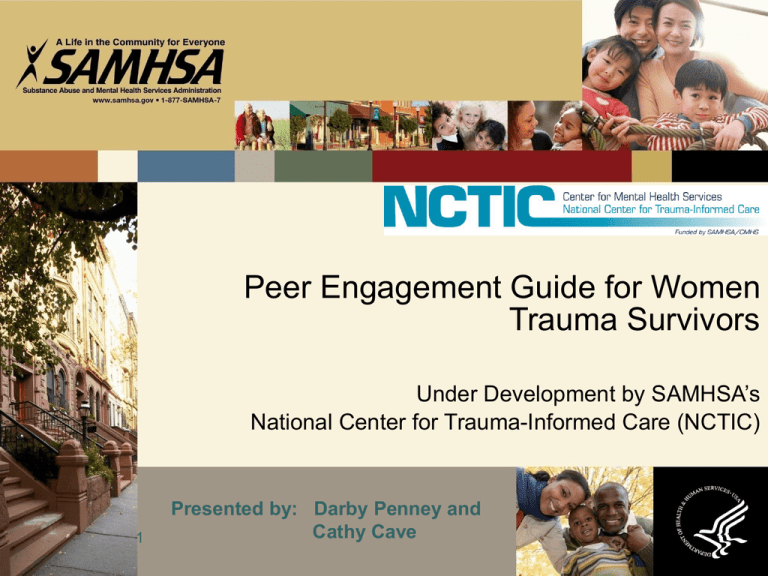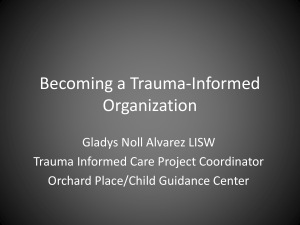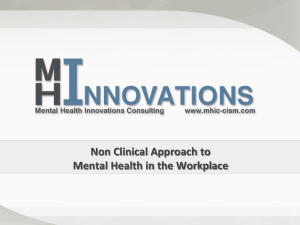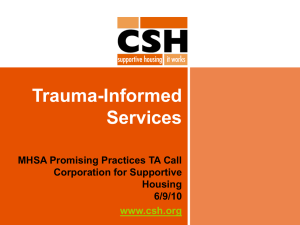CathyCave
advertisement

Peer Engagement Guide for Women Trauma Survivors Under Development by SAMHSA’s National Center for Trauma-Informed Care (NCTIC) 1 Presented by: Darby Penney and Cathy Cave SAMHSA’s National Center for Trauma-Informed Care (NCTIC) Provides technical assistance to publicly funded systems and organizations to build awareness and promote implementation of trauma informed systems and supports: – – – – – Behavioral health Criminal/juvenile justice Homeless programs Learning collaboratives Gatherings of people seeking trauma support NCTIC and Peer Leadership Unique commitment to promote peer/survivor leadership in trauma-informed systems change through: – Public education and community outreach – Workforce Development, including Peer Specialist Training – Peer-developed products – Organizational development within peer-run services and supports – Strategic planning for integration of peer/survivor voice across all health and human services systems Peer Engagement Strategies • Continue to build dialogue and awareness within consumer/survivor communities about trauma and its impact • Address trauma in the context of mental health and substance use recovery Peer Engagement Strategies • Create learning communities to enhance consumer/survivor voice and increase knowledge • Develop peer trauma champions at the national/state/local levels to ensure integration of peers in systems’ change activities. Why Women? Why Now? Peer Engagement Guide Overview Part 1: Fundamentals: – What is Trauma? – Trauma-informed services and supports – Am I a Trauma Survivor? Applying this concept to self and others – Introduction to Peer Support – Gender Politics; Criminalization of Women – Cultural Considerations Peer Engagement Guide Overview Part 2. Moving Into Action – Trauma & Peer Support relationships – Self Awareness/Self-care – Organizational contexts – Trauma-informed Peer Support Practices – Leadership, Power, Social Action – Trauma Across the lifespan – Religion and Spirituality What is Trauma? • An external threat that overwhelms a person’s coping resources • May result in long-term emotional and/or physical distress • Normal response to extreme events Some Sources of Trauma • Sexual, emotional, and/or physical abuse or neglect in childhood • Interpersonal violence in adulthood: – Rape, sexual assault – Domestic violence – Psychological, emotional, and verbal abuse – Assault, other violent crimes (experienced or witnessed) Some Sources of Trauma • Historical/generational trauma; racism, genocide, forced immigration/migration • Catastrophic injuries, illnesses • Institutional abuse (including coercion) • War • Natural disasters • Terrorism Impact of Trauma • Shatters trust, sense of safety • Often results in feelings of shame, guilt, rage, isolation & disconnection Impact of Trauma • Feelings of Powerlessness – Loss of voice – Loss of choice – Not feeling safe – Loss of control over what happens to you Research shows that the vast majority of people with psychiatric diagnoses, substance abuse problems, and/or criminal justice involvement are trauma survivors Trauma-informed Services & Supports • Ask “What happened to you?” NOT “What’s wrong with you?” • Eliminate practices that can re-traumatize people • Can be applied to any service setting Trauma-informed Services & Supports • Emphasize: – Safety – Choice – Trustworthiness – Collaboration – Empowerment Trauma-specific Interventions • Designed to treat the aftermath of trauma – EMDR – Systematic desensitization – Groups/curricula such as • Seeking Safety • TREM Understanding Cultural Considerations • Trauma survivors are found across all systems • Culture counts in what, where, and whom is viewed as helpful • Disparities exist PRIMARY dimensions influence “who” an individual is. C O C N U S L I T D U E R R A A L T I O N S English Language Proficiency SECONDARY dimensions influence an individual’s participation. Family & Extended Family Community Networks Employment Culture + History Class Knowledge/Experience Income Gender Language Age Economics Perceptions of Physical Qualities Ethnicity Geographic Political Self-identification Context Location Marital Status Education TRAUMA Geographic Location Parental Status Country of Origin Race Literacy Sexual Orientation Immigration Physical Status Abilities Military Spiritual Experience Beliefs Challenges • Stereotyping • We all have biases • It may be difficult to see and understand differing cultural perspectives Challenges • Individual cultural identities can be minimized in effort to create belonging • Individual cultural identities can mistakenly be viewed as less relevant than the shared lived experience of surviving trauma Cultural Views • Culturally, people have different beliefs and understanding: – Cause and effect – Justice – Relationship to self and others – Power • Trauma impacts these beliefs • What “surviving” means and how we cope is constantly evolving Peer Support Basics • “Peer”: an equal, someone who has faced similar challenges • “Support”: encouragement, empathy, information & assistance Peer Support Is… • People from diverse backgrounds who share a common experience come together to: – Share their strengths – Help each other cope and grow – Find understanding among likeminded people Principles of Peer Support • • • • • • • Voluntary Reciprocal Non-judgmental Respectful Direct, honest communication Power-sharing Mutual responsibility Peer Support • Not about diagnoses or symptoms • Rooted in compassion for self & others • Promotes growth & healing by: – Taking action – Building relationships among a community of equals Peer Support is… • Not just structured self-help groups or 1-1 interactions • Also: – Education – Advocacy – Activities: arts, sports, cultural, etc. – Informal support – Internet and social media Trauma-Informed Peer Support • All the basic tenets of peer support are enacted through a cultural lens • Respects each individual’s ability to name and make meaning of their own experiences • Understands the dynamics of difference and perspectives about power and conflict Trauma-Informed Peer Support •Driven by survivors’ voice and choice •Focuses on collaborative problem-solving, mutual growth, exploration and learning Trauma-informed Peer Support • Sees “coping strategies,” not “symptoms” • Focuses on building relationships, not on controlling or eliminating behaviors • Negotiates relationships based on mutual needs and comfort levels Trauma-informed Peer Support • Appreciates strengths and capabilities • Supports survivors’ decision-making • Consciously avoids re-traumatization Self-Care for Peer Supporters Protecting your empathy – Know the impact of trauma on your life – Be aware of experiences, sounds, sights, smells, and environments that are personally relevant – Know your limits – Proactively develop and use personal strategies • Get and keep a life • Have a social network • Create down time Let’s Hear From You • How might the Peer Engagement Guide be helpful to you? • Is there something missing? Presenter Info •Darby Penney • TEL: 518-729-1225; E-mail dpenney@ahpnet.com •Cathy Cave • TEL: 518-729-1261; E-mail ccave@ahpnet.com







